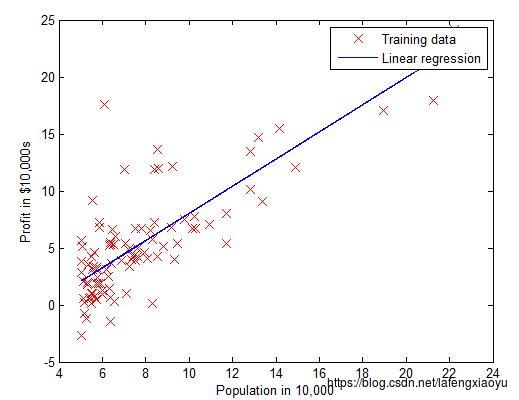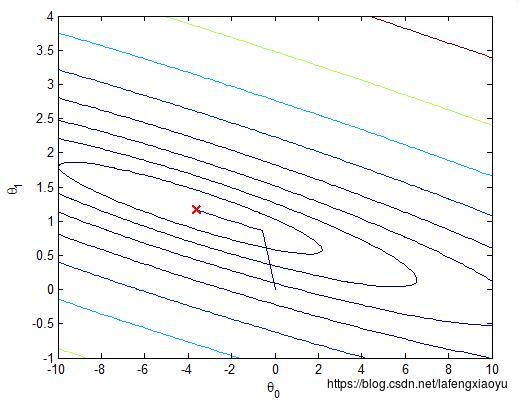机器学习1 线性回归(Linear Regression)
Posted 拉风小宇
tags:
篇首语:本文由小常识网(cha138.com)小编为大家整理,主要介绍了机器学习1 线性回归(Linear Regression)相关的知识,希望对你有一定的参考价值。
立个flag,本人从今天正式开始学习机器学习(Machine Learning)
选取的第一门课还是吴恩达(Andrew Ng)的斯坦福大学公开课 :机器学习课程,我打算从作业入手,结合课程进行学习,预计一共分为8篇,这是第一篇
单变量线性回归
给定是数据集包括97个数组,其中第一个表示人口数,第二个表示盈利数,我们希望得到两者之间的线性表达关系。下图是将点在坐标轴中绘制出来
%% ======================= Part 2: Plotting =======================
fprintf('Plotting Data ...\\n')
data = load('ex1data1.txt');
X = data(:, 1); y = data(:, 2);
m = length(y); % number of training examples
% Plot Data
% Note: You have to complete the code in plotData.m
plotData(X, y);

线性回归的目的是最小化损失函数
梯度下降
损失函数为
这里我们的假设为 hθ h θ 是下面的线性模型
hθ(x)=θTx=θ0+θ1x1 h θ ( x ) = θ T x = θ 0 + θ 1 x 1
根据批梯度下降(batch gradient descent)
θj:=θj+α∑i=1m(y(i)−hθ(x(i)))x(i)j θ j := θ j + α ∑ i = 1 m ( y ( i ) − h θ ( x ( i ) ) ) x j ( i )
或者根据随机梯度下降方法(stochastic gradient descent)求得 θ θ 的值,并且绘制出图

%% =================== Part 3: Gradient descent ===================
fprintf('Running Gradient Descent ...\\n')
X = [ones(m, 1), data(:,1)]; % Add a column of ones to x
theta = zeros(2, 1); % initialize fitting parameters
% Some gradient descent settings
iterations = 1500;
alpha = 0.01;
% compute and display initial cost
computeCost(X, y, theta)
% run gradient descent
theta = gradientDescent(X, y, theta, alpha, iterations);
% print theta to screen
fprintf('Theta found by gradient descent: ');
fprintf('%f %f \\n', theta(1), theta(2));
% Plot the linear fit
hold on; % keep previous plot visible
plot(X(:,2), X*theta, '-')
legend('Training data', 'Linear regression')
hold off % don't overlay any more plots on this figure其中计算代价函数和计算梯度下降分别为
function J = computeCost(X, y, theta)
%COMPUTECOST Compute cost for linear regression
% J = COMPUTECOST(X, y, theta) computes the cost of using theta as the
% parameter for linear regression to fit the data points in X and y
% Initialize some useful values
m = length(y); % number of training examples
% You need to return the following variables correctly
J = 0;
% ====================== YOUR CODE HERE ======================
% Instructions: Compute the cost of a particular choice of theta
% You should set J to the cost.
h = X * theta;
Jtemp= (h - y).^2;
J = sum(Jtemp) * (1/(2*m));
% =========================================================================
end和
function [theta, J_history] = gradientDescent(X, y, theta, alpha, num_iters)
%GRADIENTDESCENT Performs gradient descent to learn theta
% theta = GRADIENTDESENT(X, y, theta, alpha, num_iters) updates theta by
% taking num_iters gradient steps with learning rate alpha
% Initialize some useful values
m = length(y); % number of training examples
J_history = zeros(num_iters, 1);
for iter = 1:num_iters
% ====================== YOUR CODE HERE ======================
% Instructions: Perform a single gradient step on the parameter vector
% theta.
%
% Hint: While debugging, it can be useful to print out the values
% of the cost function (computeCost) and gradient here.
%
h = X * theta;
hmy = (h-y) .* X(:,1);
hmyx =(h-y) .* X(:,2);
val = sum(hmy) * (1/m);
val1 = sum(hmyx) * (1/m);
temp1 = theta(1) - (alpha * val) ;
temp2 = theta(2) - (alpha * val1) ;
theta(1) = temp1;
theta(2) = temp2;
%delta = [val;val1];
%theta = theta - delta .* alpha;
%computeCost(X, y, theta)
%theta
% ============================================================
% Save the cost J in every iteration
J_history(iter) = computeCost(X, y, theta);
end
end可视化 J(θ) J ( θ )
在三维空间画出 J(θ) J ( θ ) 关于 θ0 θ 0 和 theta1 t h e t a 1 的图并且在图中显示出变化情况如下图所示
| 三维图 | 等高线图 |
|---|---|
 |  |
代码如下
%% ============= Part 4: Visualizing J(theta_0, theta_1) =============
fprintf('Visualizing J(theta_0, theta_1) ...\\n')
% Grid over which we will calculate J
theta0_vals = linspace(-10, 10, 100);
theta1_vals = linspace(-1, 4, 100);
% initialize J_vals to a matrix of 0's
J_vals = zeros(length(theta0_vals), length(theta1_vals));
% Fill out J_vals
for i = 1:length(theta0_vals)
for j = 1:length(theta1_vals)
t = [theta0_vals(i); theta1_vals(j)];
J_vals(i,j) = computeCost(X, y, t);
end
end
% Because of the way meshgrids work in the surf command, we need to
% transpose J_vals before calling surf, or else the axes will be flipped
J_vals = J_vals';
% Surface plot
figure;
surf(theta0_vals, theta1_vals, J_vals)
xlabel('\\theta_0'); ylabel('\\theta_1');
% Contour plot
figure;
% Plot J_vals as 15 contours spaced logarithmically between 0.01 and 100
contour(theta0_vals, theta1_vals, J_vals, logspace(-2, 3, 20))
xlabel('\\theta_0'); ylabel('\\theta_1');
hold on;
plot(theta(1), theta(2), 'rx', 'MarkerSize', 10, 'LineWidth', 2);
多变量线性回归
这里举的例子是波特兰当地的房价与两个因素之间的关系,分别是房间的大小以及卧室的数目。
特征数据归一化处理
首先我们需要进行标准化处理,因为面积大约是房间数的一千倍,如果直接按照数字处理显然会有很大误差,因此我们这里需要做正规化处理,求出两个特征的平均值和方差,然后再用每个数据减去平均值后在除以标准差,这样的数据符合标准正态分布。
归一化处理的函数如下
function [X_norm, mu, sigma] = featureNormalize(X)
%FEATURENORMALIZE Normalizes the features in X
% FEATURENORMALIZE(X) returns a normalized version of X where
% the mean value of each feature is 0 and the standard deviation
% is 1. This is often a good preprocessing step to do when
% working with learning algorithms.
% You need to set these values correctly
X_norm = X;
mu = zeros(1, size(X, 2));
sigma = zeros(1, size(X, 2));
% ====================== YOUR CODE HERE ======================
% Instructions: First, for each feature dimension, compute the mean
% of the feature and subtract it from the dataset,
% storing the mean value in mu. Next, compute the
% standard deviation of each feature and divide
% each feature by it's standard deviation, storing
% the standard deviation in sigma.
%
% Note that X is a matrix where each column is a
% feature and each row is an example. You need
% to perform the normalization separately for
% each feature.
%
% Hint: You might find the 'mean' and 'std' functions useful.
%
mu = mean(X)
sigma = std(X)
for i = 1:size(X,2)
X_norm(:,i) = ((X(:,i) - mu(:,i))/sigma(:,i));
end
% ============================================================
end梯度下降
与之前单变量的做法一样,只不过
θ
θ
的数目变了而已
并且在多变量情况下,代价函数
J(θ)
J
(
θ
)
可以表示为如下的向量形式
其中 X=⎡⎣⎢⎢⎢⎢⎢−(x(1))T−